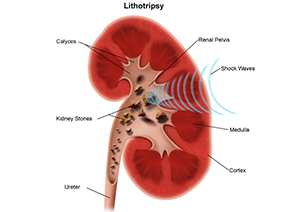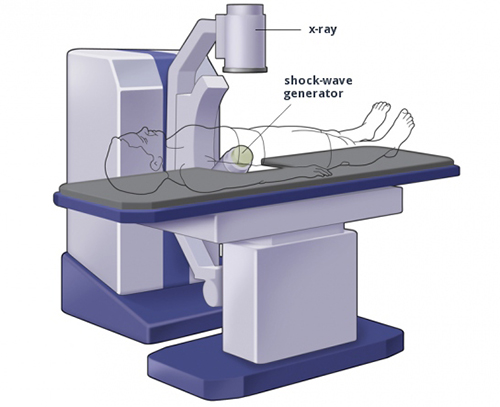
What is Extracorporeal Shockwave Lithotripsy?
Kidney stones are mineral deposits that can develop in the kidneys. Lithotripsy, often referred to as extracorporeal shockwave lithotripsy (ESWL), is the most common procedure for the management of kidney stones (nephrolithiasis). It uses focused sound waves to break up stones that form in the kidney, bladder or ureter, enabling easy passage of the fragments out of the body within the urine.
Many kidney stones are small and can be passed in the urine. However larger stones are unable to pass through the ureters and can cause bleeding, kidney damage or urinary tract infections and may require more invasive treatment.
Lithotripsy is indicated in people with larger kidney stones that are not passing on their own, or are too large to safely pass.
Diagnosis of Kidney stones
Your history and symptoms may raise suspicion of kidney stones. Laboratory tests, including urine and blood, are often performed to look for signs of kidney stones. Imaging studies, such as Xray, ultrasound, and CT scans are used to look directly for a stone and estimate how large it is.

Procedure of Lithotripsy
During lithotripsy, you will lie on a water-filled cushion. High-energy sound waves that are created outside of the body travel through the body until they hit the kidney stones and break them into tiny pieces. You may feel a tapping sensation on your skin as the shockwaves enter the body, but as the procedure is done with sedation most patients do not recall anything.
You will be taken to the recovery room to be monitored for a couple of hours after the procedure. Lithotripsy is usually an outpatient procedure where you can go home on the same day. You can usually resume regular activities within a day or two. You may experience pain when the stone fragments pass, which occurs soon after treatment and may last for 4 to 8 weeks. Oral pain medications are prescribed to relieve pain. You will be instructed to drink plenty of water to help clear the stone fragments out of your urinary system.
What are the Potential Risks and Complications associated with Lithotripsy?
Lithotripsy is considered a relatively safe procedure, but as with any medical procedure, there may be risks involved. Some risks associated with lithotripsy include:
- Bleeding in or around the kidney
- Bruising of the back where the shockwaves passed
- Kidney infection
- Failure to remove the stones requiring additional treatment
- Pain if a stone fragment blocks the flow of urine
- Temporary damage to the kidney
